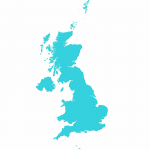O2 Expands 5G Mobile to 60 UK Sites and LTE-M to 10,000 Sites

Mobile operator O2 has today announced that their new ultrafast 5G based mobile broadband network is now live across parts of 60 UK towns and cities (up from 20 at the start of 2020), which puts them ahead of their target (50 places by summer). On top of that they’ve extended their roll-out of 4G based LTE-M to 10,000 sites.
The operator’s 5G network first went live in busy areas of Belfast, Cardiff, Edinburgh, London, Slough and Leeds during October 2019, which was followed by Leicester and Lisburn in November 2019 and then Manchester, Birmingham, Glasgow, Liverpool, Newcastle, Bradford, Sheffield, Coventry, Nottingham, Norwich, Bristol, Derby and Stoke in January 2020.
O2 had originally intended to reach 50 locations by summer 2020, but they appear to have beaten that by 10. Otherwise the operator, much like some of their rivals, only has access to a 40MHz slice of the 3.4GHz band, which will make it difficult for them to deliver on 5G’s much hyped gigabit speeds, but further radio spectrum bands are due to be auctioned off by Ofcom later in 2020.
Advertisement
The additional locations include key cities such as Aberdeen, Brighton and Oxford (the full list is pasted at the bottom of this article), although it’s worth reminding readers that it will often take awhile for O2 to fully extend their 5G coverage to reach right the way across each of these locations.
Brendan O’Reilly, CTO of O2, said:
“O2 is at the forefront of connectivity which is now one of the UK’s most valued services. Our customer-centric networks, underpinned by 5G and LTE-M technologies, will help power this country into recovery as we look to rebuild Britain. As the UK faces an uncertain year ahead, it’s vital we continue to invest in new innovations and technologies to keep Britain mobile and connected.
I believe technologies like 5G and LTE-M are going to revolutionise the way people and businesses use mobile connectivity, unlocking huge possibilities for our economy and society. We’re excited to be getting this next generation tech into the hands of more of our customers, with tariffs that are flexible and affordable.”
On top of the 5G deployment, O2 has also announced that they’ve extended the coverage of their 4G based LTE-M (Long Term Evolution for Machines – Category M1) network to 10,000 sites (it was only 50 in February 2020), which is a Low Power Wide Area Network (LPWAN / LPWA) service that is designed to connect Internet of Things (IoT) devices.
The operator is one of the first in the UK to deploy LTE-M, although Three UK are conducting a similar pilot (here). Such networks tend to only use a tiny amount of spectrum bandwidth (1.4MHz – 5MHz) in order to deliver fairly slow mobile broadband speeds (1 – 7Mbps). But this is largely irrelevant since the small IoT kit that it’s designed to connect (e.g. traffic lights, environment sensors etc.) usually only require 0.1Mbps+.
All of this makes LTE-M a useful alternative to older 2G networks, which are still in quite a bit of use today due to their low power requirements and high coverage. The operator’s decision to extend their deployment to 10,000 sites (mostly across the east of the country) – covering 57% of premises – is effectively equivalent to a national roll-out and they’re the first UK operator to make that leap.
Advertisement
Elsewhere O2 currently offers 4G in 19,185 cities, towns and villages across the UK and between Jan – May this year, it has upgraded 4G capacity in 90,954 UK postal codes. In total, O2 invests over £2m a day in its network and their 5G deployment is being supplied by both Nokia and Ericsson.
The 60 UK 5G Locations
Aberdeen, Ashford, Banstead, Basildon, Belfast, Birmingham, Bradford, Brighton, Bristol, Cardiff, Chatham, Chesterfield, Coventry, Dartford, Derby, Dundee, Eastbourne, Edinburgh, Esher, Gateshead, Gillingham, Glasgow, Grays, Hemel Hempstead, Huddersfield, Hull, Leeds, Leicester, Lisburn, Liverpool, London, Lowestoft, Luton, Manchester, Mansfield, Middlesbrough, Newcastle Upon Tyne, Newtownabbey, North Shields, Northampton, Norwich, Nottingham, Oxford, Peterborough, Plymouth, Rainham, Redhill, Rotherham, Sheffield, Slough, South Shields, Stoke-on-Trent, Sunbury, Sunderland, Thundersley, Warrington, Weybridge, Windsor, Worthing and York.
Mark is a professional technology writer, IT consultant and computer engineer from Dorset (England), he also founded ISPreview in 1999 and enjoys analysing the latest telecoms and broadband developments. Find me on X (Twitter), Mastodon, Facebook, BlueSky, Threads.net and Linkedin.
« UK Mobile Firms Remove Data Charges on Sites Supporting Victims of Crime
Openreach Extend G.INP to More ECI FTTC Broadband Lines »






















































yet in burnley i get 3-6mbps on 4g+ but theres nothing wrong in the area they say locked into a 2 year contract
Shame to see things don’t change with O2 then, glad I went elsewhere.
I am wondering why they still have so many customers. They are clearly much worse than Three.
In my experience as recent as yesterday, Three is a network to stay away from too, not just for performance but the customer service is terrible, even the retentions team who phoned about the contract being cancelled by PAC was acting suspicious and barely understandable.
As for pwrformance O2 has been rolling out 4G on 1800/2100mhz for a while now so can’t comment to much so ita possible they’re giving three a run for their money there.
Hi my name is Camilla stone I’ve been an O2 customer for
About 25 years and I’ve had no problems with O2.
I’ve got a Nokia phone and it still works.
Kind regards
Camilla Stone.
Will be nice when they upgrade to 3/4G in my area, still only 2G masts, still we got EDGE upgrade about 5 years ago.
I am J’sanywhere Hello World are you sure before I turn my Samsung mobile phone off for good do you need optimisation done today get back ASAP PJM
Paragraph of point “Otherwise the operator, much like some of their rivals, only has access to a 40MHz slice of the 3.4GHz band, which will make it difficult for them to deliver on 5G’s much hyped gigabit speeds, but further radio spectrum bands are due to be auctioned off by Ofcom later in 2020.”
Is this an example that the regulator maximising profits before actual investment in infrastructure?
I ask because the way the regulator seems confident in selling paltry, piddling little chunks of spectrum is doing absolutely nothing for the availability of fast internet access in the UK. IMHO spectrum should be sold in 100mhz chunks minimum in this day and age and those who want to buy more should be allowed to buy chunks in 1000mhz grouped together sections.
buggerlugz – I completely agree.
Upgrading a mast costs a LOT of money putting gigabit capable equipment onsite and then crippling it with the likes of 1.4, 10, 20 or 40MHz of bandwidth is an absolute farce.
This will be congested by customer demand to “near useless” in a mere matter of weeks.
Instead, some sensible actions need to be taken here like ONLY issuing contiguous 100MHz
Anything else, just creates mass complexity and wasted base station resource and a terrible customer experience which tarnishes operator reputations.